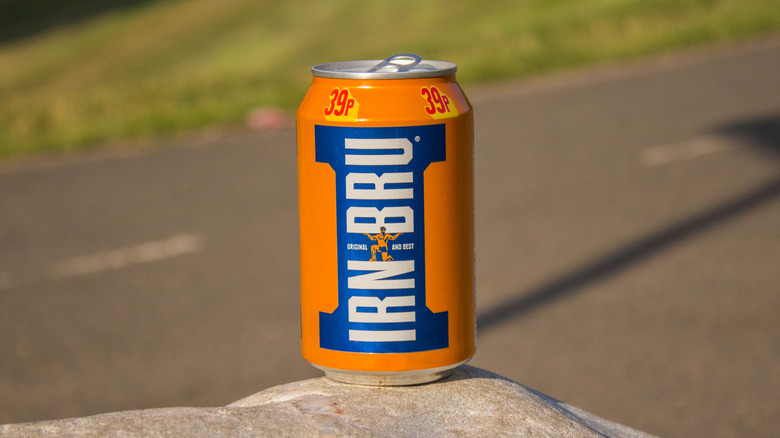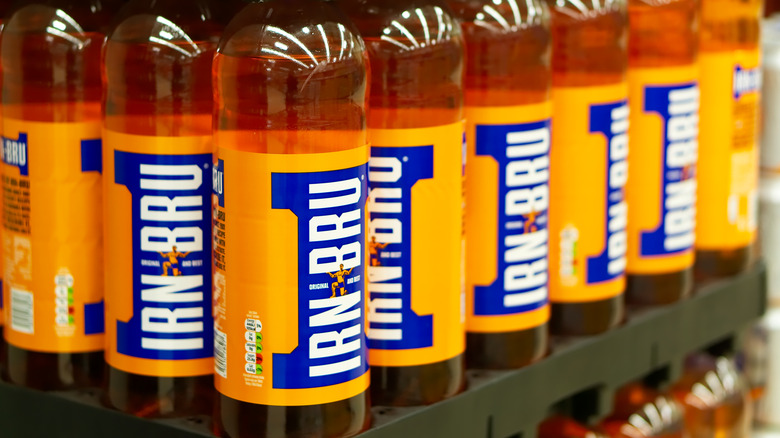What Exactly Is Irn-Bru, And What Does It Taste Like?
Irn-Bru is the most popular soft drink in Scotland, more popular even than Coca-Cola according to some. When Donald Trump tried to have it banned at his Scottish resort, he was blasted by the Scottish people. So, if its flavor has made it so monumentally popular in the land of thistles and tartans, what exactly does Irn-Bru taste like?
First sold in Scotland in 1901 by soft drink manufacturer A.G. Barr & Company under the name "Iron Brew," Irn-Bru is perhaps one of the most peculiar among peculiar drinks. Fizzy and bright orange, its sweet and tangy flavor is, naturally, a result of its unique mixture of ingredients. It is also quite unplaceable.
The exact recipe has never fully been released to the public, though we do know that it includes quinine and caffeine. The legend goes that caffeine was added to the tonic to give exhausted steelworkers an extra boost to make it through the working day as they worked rebuilding Glasgow Central Station.
As readers may have guessed, this connection is what gave the drink its original name, and much of its marketing has similarly played up this angle. Its logo features a giant "I" in the shape of a metal beam. For a while, the joke was that Irn-Bru's fortifying qualities came from the fact that it was made from girders.
So does it taste like iron?
The idea of a soda being made from metal girders is, of course, quite silly. Shockingly enough, though, Irn-Bru does contain iron, namely ammonium ferric citrate, a form of iron hydroxide. Before readers start worrying, we should say that the amount of iron in Irn-Bru is very, very tiny, coming in at around 0.002%, and safe for human consumption.
In fact, the reason behind the switch in the name — from "Iron Brew" to "Irn-Bru" — has to do with post-war food regulations that mandated food brand names be "literally true," which prompted A.G. Barr & Company to change the drink's name to its current, phonetic spelling in 1947. In any case, the "made from girders" rumor was, of course, a joke. The amount of iron is far from enough to make the drink taste like metal, though it does give it a slight acidity.
Irn-Bru's unique taste — and the disagreements over what exactly it tastes like — continues to be a key selling point for it, though. Advertisements for the drink have people fighting over whether it tastes like melon, tutti frutti, cream soda, lemon, ginger, bubblegum, sherbet, orange, rhubarb, or any other number of foods. Other drinkers have claimed that "Scotland's other national drink" (next to whisky) tastes like marshmallows or salty bananas.
It tastes like ... the color orange
Irn-Bru isn't likely to give up its secret recipe anytime soon, which means that in all likelihood the debate over its flavor will continue to rage. Fans will, as the ads say, just have to agree that it tastes magic, bellissimo, gorgeous, or whatever other positive adjectives they can think of.
Many fans of Irn-Bru posted on social media that they think it tastes like orange. However, none of them meant the flavor of the fruit, but rather how they believed the color orange would taste. An Irn-Bru drinker summed it up best on Twitter: "Weird how irn bru tastes like orange the colour but not the fruit orange."
This kind of description isn't completely unique to Irn-Bru. Those who have kept up with the disagreements over the flavor of McDonald's new Grimace birthday milkshake will likely have encountered those who, unable to come up with a more specific description, simply say it tastes like its color.


